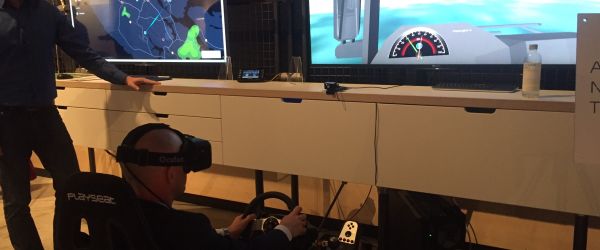Driving Simulator
The first part of the project consisted in developing a simulation tool representing a vehicle platoon that is driving along a two-lane highway. This two-lane highway would later merge into a one-lane road due to, for instance, roadwork. The challenge was to make the transition from two lanes to one lane as smooth as possible, so that the flow of vehicles is uninterrupted, and to develop a robust communication protocol for vehicle-to-vehicle communication. The second part of the project was about developing a driving simulator using virtual reality technology. The idea was to connect an Oculus Rift headset with pedals and gearstick to a computer, and give the user the illusion of driving a bus in a simulated 3D world. This project was cooperation between Ericsson and the Integrated Transport Research Labs (ITRL), and was demoed at Ericsson Studio for a number of people in the transportation and telecommunications industry, as an example on how communication technology can be used to improve transports.

We start by defining a circular road, where the vehicles should drive on and a simple vehicle model with only two inputs. The first input is acceleration and the second input is the angular velocity of the vehicle. We derived a controller that maintains the vehicle in the centerline of the road. A simple proportional controller generates the angular velocity. The acceleration signal adjusts the speed of the vehicle. The vehicle should slow down in curves and avoid collisions with other vehicles while maintain a speed below the speed limit. At the same time the platoon should drive as smoothly as possible. Therefore we designed our own platooning controller that could handle these situations. We also developed a communication protocol so that the vehicles communicate with each other when they wanted to change lane, such that the vehicle ahead slows down and opens a gap for the other vehicle.
Our role in the second project was to model the moving autonomous vehicles, as well as the bus that the user is driving. To model the autonomous vehicles we used the same controller as in the first project. The vehicles here had to be able to stop at red lights, and follow the specific speed limits at the streets.
Niklas Bergh
